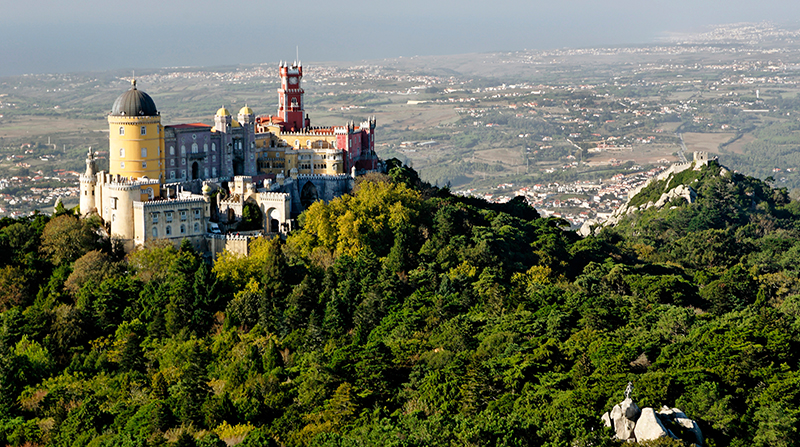
It’s time to say olá, Portugal — and with good reason. Portugal may have been on the map since 1138 (it even rewrote the map during the Age of Discovery 500 years ago), but its heyday is now thanks to a phalanx of non-stop flights to Lisbon, its wallet-friendly affordability and limitless adventures.
If you’re planning to get to know Lisbon, you’ll want to work your trip around a weekend in Sintra. For centuries, the hillside town has been a revered outdoor retreat. Long before Portuguese nobility set up summer homes here for the fresh air and spectacular views, the Celts and Romans celebrated Sintra’s verdant vegetation and worshiped the moon gods. Moorish princes also would set up impassible outposts in its hills.
Just a 30-minute drive from the Portuguese capital, the fairytale town where castles bloom on the hillside is listed as a UNESCO cultural landscape.
When you get there, drop your bags at Tivoli Palácio de Seteais Sintra Hotel, an 18th-century neoclassical palace that captures the region’s romantic vibe. The 30-room property is both a period piece and hilltop kingdom — rooms follow the building’s original décor while the sprawling grounds consist of gardens with fruit trees, herbs and a topiary maze, tennis courts and a panoramic pool area overlooking the countryside.
https://www.instagram.com/p/BYX0-hLj9Nm/?taken-by=visitportugal
From the Palácio, it’s a relaxing 10-minute walk to Quinta da Regaleira, Sintra’s most eclectic estate. The Regaleira palace is an architectural mélange of Gothic, Roman, Moorish and Renaissance features and its four-hectare grounds are ripe for exploration — discover the decorative gazebos, waterfalls, tunnels and even the Initiation Wells, a pair of subterranean spiral towers.
Head back to your hotel for a sunset view just behind Palácio de Seteais’ own historic landmark — a neoclassical arch built in 1802 in honor of Portugal’s Prince regent John VI and Princess Carlota Joaquina.
As dusk descends, make your way to dinner in the palace’s grand salon, an elegant restaurant led by chef Miguel Silva, whose concept of revisited Portuguese cuisine is a celebration of the country’s best fish dishes as well as farm-to-table recipes.
Day One
Wake up early and put on comfortable shoes. The hilltops of Sintra are known for beautiful trekking, but if you need the extra minutes of beauty sleep, you can also take a taxi to the day’s destination.
By 9 a.m., you’ll want be at the Parque de Sintra’s Palacio de Pena entrance to queue for tickets. The Parcque de Sintra is a wooded labyrinth on the town’s Monte da Lua, where cultural sites flourish, including the colorful Palace of Pena, the beautiful Palace of Monserrate, the medieval Moorish Castle and the wild Convent of the Capuchos.
It’s easy to lose yourself in the castles, and even more so in the surrounding forest grounds where you’ll find monuments, gardens, lakes and other royal amusements.
Make sure to plan the day in advance; think about whether you’d rather economize your time with a combination Pena/Moorish Castle ticket with bus service or, for the more ambitious, the all-in-one five-park pass.
For equestrians, the most beautiful way to see the sights is on horseback.
Make the windy two-mile trek back to Sintra’s city center, or hop in a tuk-tuk for a bumpy ride down the one-lane road. The tiny town is an intriguing maze of historic buildings, shops and eateries and, lately, it’s become a popular destination, so make sure to book dinner reservations in advance. Some of our favorite spots are Tascantiga, a contemporary tapas restaurant, and Tacho Real for traditional Portuguese dishes.
https://www.instagram.com/p/BYDWFXlge6w/?taken-by=tivolihotels
Day Two
After storming all the castles of Sintra, you deserve to center your second day on some R&R. If you’re visiting on a weekend, start things off with Sunday brunch in the hotel’s frescoed dining room. From local favorites like queijadas (tiny egg pastries made with local cheese) to salads featuring fresh herbs and vegetables and tasty omelets, the spread is a cornucopia of not-to-be-missed delights.
Take your day of indulgence to the next level with a decadent massage. The palace’s dovecote has been converted into Anantara Seteais Spa, a sanctuary combining world-renowned Thai techniques with local ingredients (lavender, rosemary, regional Colares wine) to create treatments that reflect both a sense of history and place.
Once you’ve been pampered, stake your claim at one of the poolside cabanas at the Seteais’ glamorous swimming hole, a wood-paneled pool overlooking the countryside.
Enjoy a traditional Portuguese cataplana (seafood stew) at the outdoor restaurant before heading back to Lisbon.
